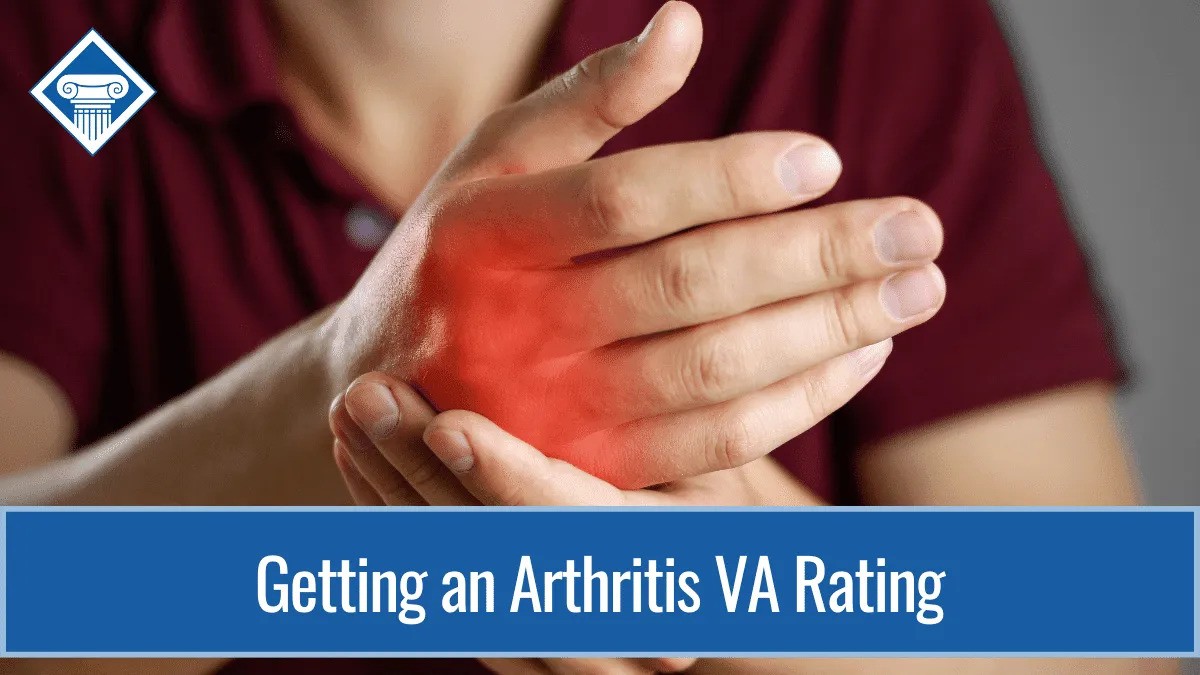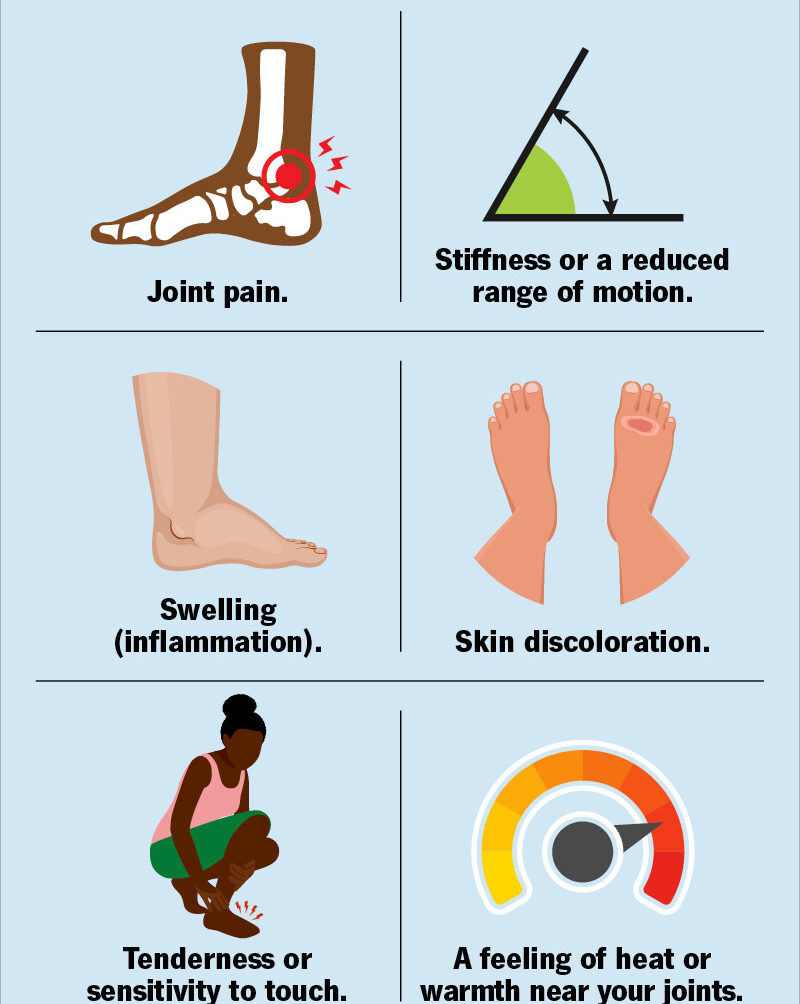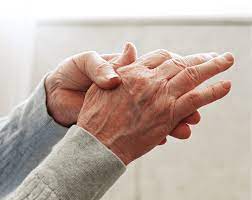Arthritis
VA Rating for Arthritis
If you struggle to complete daily tasks because of arthritis that was caused or worsened by your military service, you may be eligible for VA compensation. This post explains the VA rating for arthritis and how you can receive the benefits you deserve.
Months, or even years, of carrying heavy military gear while on active duty can take a toll on your joints. Additionally, the rigorous physical training and injuries you may have experienced during service increase your risk of irreversible joint and bone damage.
What may feel like minor discomfort now can lead to more serious issues such as arthritis as you age, and as the condition slowly progresses.


What is arthritis?
Though the word itself means inflammation, or redness and swelling, of the joints, arthritis refers to more than 100 conditions. These conditions all affect the connective tissue surrounding the joints. Of the many manifestations of arthritis, however, the two that most commonly affect Americans are rheumatoid arthritis and osteoarthritis.
Rheumatoid arthritis is an autoimmune disorder in which your immune system attacks healthy cells, resulting in joint inflammation. It can be genetic, hormonal, or brought on by environmental factors. Studies have also shown that veterans who have been exposed to inorganic dust from military jobs like welding, vehicle maintenance, and explosives detonation are at a higher risk of developing rheumatoid arthritis.
On the other hand, osteoarthritis, also called degenerative arthritis or “wear and tear” arthritis, is caused by repetitive use or overuse of joints over time. Though it’s long been considered an age-related disease, researchers have found that joint injuries, which can occur at any age, are a risk factor of osteoarthritis. This article will focus on osteoarthritis.
Arthritis in veterans
More than 1 in 3 veterans develop arthritis, compared to 1 in 4 civilians, with osteoarthritis being the most common type among both groups. While osteoarthritis can affect any joint, it’s most often found in the hands, spine, hips, and knees. Its effect on these joints is why it can be particularly burdensome for veterans who’ve spent countless hours carrying heavy equipment, weapons, and body armor.
“Think about all of the PT you did in combat boots, all of your ruck marches, all of the fast roping, rappelling, and parachuting. The wear and tear on your load-bearing joints may have been a minor issue when you were younger, but as you age, those injuries can no longer be ignored,” said VA disability lawyer Zack Evans.
Symptoms of osteoarthritis may include:
VA rating for arthritis in the back
Just as the VA rates other major joints and minor joint groups, the VA rating for arthritis in the back is calculated on the basis of limitation of motion. Without significant limitation of motion, arthritis in the back can still warrant you a 10% or 20% rating under DC 5003.
The lower back, upper back, and neck joints are all considered minor joint groups. The VA refers to the lower back and upper back as the thoracolumbar spine, and the neck as the cervical spine. Ankylosis is the stiffening or immobility of a joint.
Description |
VA Rating |
Monthly Payment
|
|---|---|---|
Unfavorable ankylosis of the entire spine |
100% |
$3,831.30 |
Unfavorable ankylosis of the entire thoracolumbar spine |
50% |
$1,102.04 |
Unfavorable ankylosis of the entire cervical spine; or, forward flexion of the thoracolumbar spine 30 degrees or less; or, favorable ankylosis of the entire thoracolumbar spine |
40% |
$774.16 |
Forward flexion of the cervical spine 15 degrees or less; or, favorable ankylosis of the entire cervical spine |
30% |
$537.42 |
Forward flexion of the thoracolumbar spine greater than 30 degrees but not greater than 60 degrees; or, forward flexion of the cervical spine greater than 15 degrees but not greater than 30 degrees; or, the combined range of motion of the thoracolumbar spine not greater than 120 degrees; or, the combined range of motion of the cervical spine not greater than 170 degrees; or, muscle spasm or guarding severe enough to result in an abnormal gait or abnormal spinal contour such as scoliosis, reversed lordosis, or abnormal kyphosis |
20% |
$346.95 |
Forward flexion of the thoracolumbar spine greater than 60 degrees but not greater than 85 degrees; or, forward flexion of the cervical spine greater than 30 degrees but not greater than 40 degrees; or, combined range of motion of the thoracolumbar spine greater than 120 degrees but not greater than 235 degrees; or, combined range of motion of the cervical spine greater than 170 degrees but not greater than 335 degrees; or, muscle spasm, guarding, or localized tenderness not resulting in abnormal gait or abnormal spinal contour; or, vertebral body fracture with loss of 50 percent or more of the height |
10% |
$175.51 |
Other conditions related to arthritis
As mentioned previously, there are lots of different types of arthritis that affect veterans, including conditions like gout and ankylosing spondylitis, which many don’t realize are kinds of arthritis.
Some conditions, like lupus, can contribute to a veteran developing arthritis. Additionally, there are a number of conditions which may be secondary to arthritis, including:
- Bone spurs. Also known as osteophytes, bone spurs occur when bony growth develops on the edge of a bone. Bone spurs can sometimes be secondary to osteoarthritis. Although the VA won’t give you a rating for bone spurs, you can get a rating on the basis of pain caused by the condition.
- Fibromyalgia. Both osteoarthritis and rheumatoid arthritis are risk factors for developing fibromyalgia. The VA rates fibromyalgia under DC 5025 and grants a 10%, 20%, or 40% rating for the condition depending on severity.
- Depression. It’s not unheard of for veterans to develop certain mental illnesses as a result of arthritic pain. Depression can arise when persistent joint pain causes a veteran to lose their job, or keeps them from enjoying hobbies or doing tasks they once could. The VA rates depression using the General Rating Formula for Mental Disorders, and can grant a rating between 0% and 100%.
- Insomnia. Overwhelming joint pain can make it difficult to fall or stay asleep, resulting in insomnia. Just like depression, insomnia is rated using the general rating formula for mental disorders. Ratings depend on the severity of your symptoms, how frequently they occur, and how much the condition interferes with your life.
- Costochondritis. Arthritis causes inflammation of the joints. It can damage rib cartilage and affect joint functioning, resulting in costochondritis, also known as Tietze syndrome. Costochondritis causes inflammation in the ribcage.
TDIU: How arthritis can keep you from working
Depending on the affected joints and the severity of your condition, arthritis can make it hard to work not only physically demanding jobs, but sedentary jobs as well. You may struggle with heavy lifting or being on your feet for long periods of time, but may also have a hard time typing, answering calls, or using fine motor skills. You may be eligible for total disability based on individual unemployability (TDIU) for your arthritis if it prevents you from working.
Even if you don’t qualify for TDIU from an osteoarthritis rating alone, you could receive VA individual unemployability if the combined effects of your service-connected conditions keep you from working.
To be eligible to receive TDIU, you must:
1
At least one service-connected disability rated at 60% or more disabling OR
2
Two or more service-connected disabilities with at least one rated at 40% or more disabling and a combined rating of 70% or more
How VA can help
Although TDIU or a higher VA rating can’t reverse a diagnosis, VA disability compensation can help you live more comfortably without work.
The VA-accredited attorneys at VA can examine your osteoarthritis diagnosis and any secondary conditions you may have to help get you TDIU.
VA has worked with thousands of veterans nationwide to get them the VA benefits they deserve. Call us for a free case evaluation to find out how we can help. If we take your case, you only pay us a percentage of your back pay if we win.

